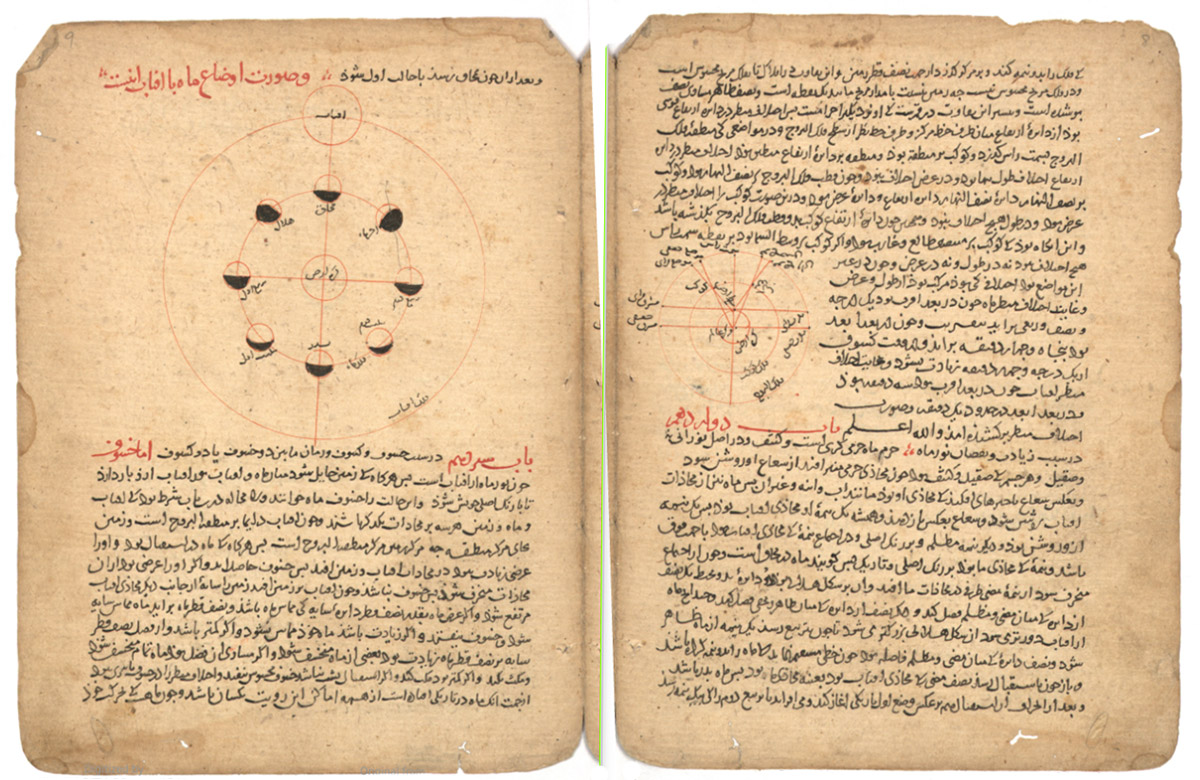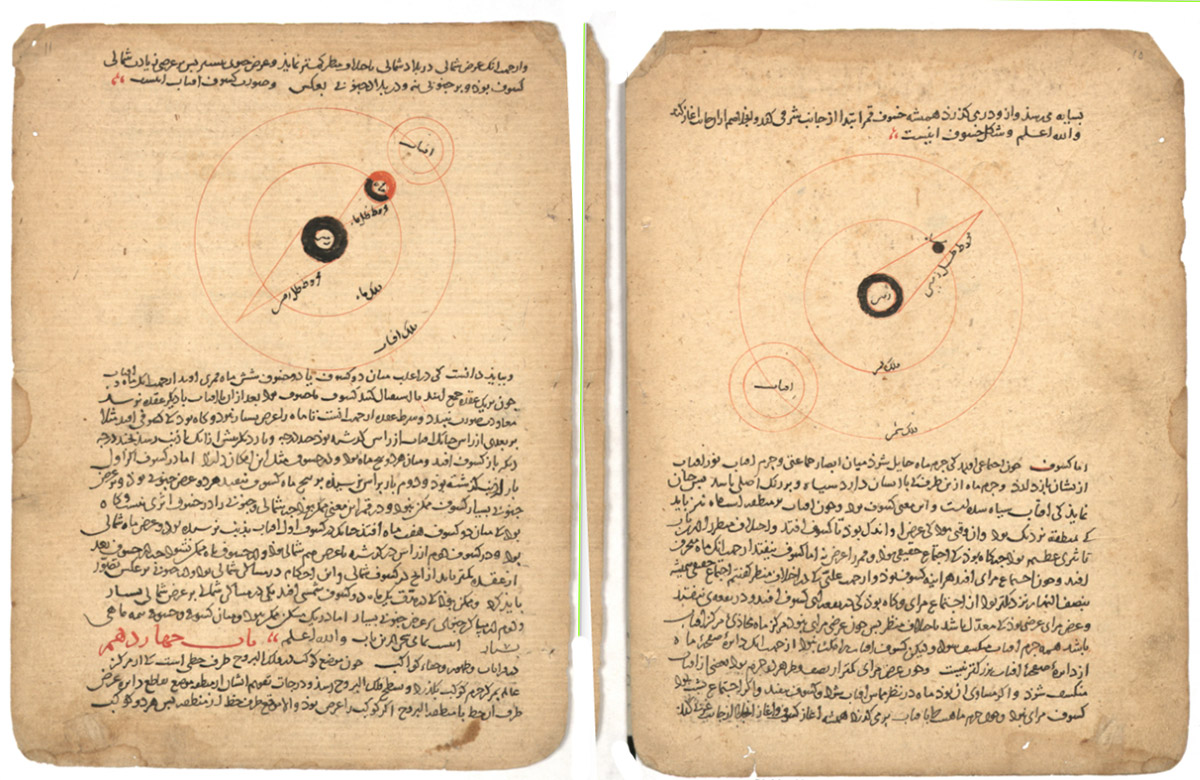Mathematical Models: Naṣīr al-Dīn Ṭūsī (d.1274)
13th century Marāghah
A capacious scholar and scientist of the religious sciences, philosophy, and mathematics as well as astronomy, Naṣīr al-Dīn Ṭūsī (d.1274) was a towering and influential intellectual figure of the 13th century. After his education he found patronage and joined the entourage of the Il-Khān ruler Hülegü (d.1265), becoming court astrologer and director of religious endowments. Later on, he oversaw the construction of the marṣad (observatory) founded at the Mongol stronghold of Marāghah and became its first director. This observatory represented “one of the most ambitious scientific institutions established up to that time,” attracting many well-known astronomers, mathematicians and students (including Chinese astronomers). (cf Ragep, “al-Ṭūsī, Naṣīral-Dīn, Abū Djaʿfar Muḥammad.” EI2)
Ṭūsī wrote prolifically in Arabic and Persian, especially on astronomy and mathematics. His recensions of Greek and early Islamic scientific works (often including his own commentary) made accessible to students the Greek scientific tradition. Among these texts were Euclid’s Elements and Ptolemy’s Almagest, as well as treatises to be studied between them, including those by Autolycus of Pitane, Aristarchus of Samos, Archimedes, Hypsicles, Theodosius of Bithynia, Menelaus of Alexandria, Thābit ibn Qurrah and the Banū Mūsá.
His original contributions were significant as well. In mathematics, he tackled Euclidean geometry and advanced the development of trigonometry as an independent discipline, comparable to that accomplished later in Europe by Regiomontanus (d.1476). However, he was most recognized for his contributions in astronomy. He wrote numerous treatises on instruments, practical astronomy, astrology, and cosmography and compiled an astronomical handbook known as Zīj-i Īlkhānī which became a model for later efforts among Muslim astronomers.

- رساله معینیه یا المفید در هیئت
- نصیر الدین طوسی
- [Risālah-i Muʻīnīyah yā al-Mufīd dar hayʼat].
- Naṣīr al-Dīn Ṭūsī (d.1274).
- Copied 14th or 15th century?
- Persian.
- Manuscript codex on Persianate laid paper.
- Isl. Ms. 823, p.8/9.

- رساله معینیه یا المفید در هیئت
- نصیر الدین طوسی
- [Risālah-i Muʻīnīyah yā al-Mufīd dar hayʼat].
- Naṣīr al-Dīn Ṭūsī (d.1274).
- Copied 14th or 15th century?
- Persian.
- Manuscript codex on Persianate laid paper.
- Isl. Ms. 823, p.10/11.
Perhaps his most original achievement was in planetary theory. To resolve the inconsistencies of the Ptolemaic system, in particular violation of the principle of uniform circular motion, Ṭūsī proposed a cunning device which he incorporated into his lunar and planetary models. This device consisted of two circles, one twice as large, the other internally tangent to it and rotating twice as fast in the opposite direction. A given point on the smaller circle would oscillate along a straight line. This allowed him to provide a solution for latitudinal planetary motion within the Ptolemaic system while retaining uniform circular motion. Subsequently expanded to multiple versions known to us now as the “Ṭūsī couple” (cf Kennedy 1966 p.370 and Ragep 2017 p161) this influential device would be used extensively by astronomers in place of the equant concept proposed by Ptolemy.
This small, fragmentary manuscript carries what appears to be a portion of Naṣīr al-Dīn Ṭūsī’s Risālah-i Muʻīnīyah an astronomical work composed ca. 1235 and dedicated to Abū al-Shams Muʻīn al-Dīn, son of the author’s patron Nāṣir al-Dīn Muḥtasham, governor of Quhistān. It was in this work that Ṭūsī introduced the first version of his Ṭūsī couple. (cf Ragep 2017 p163)
Only the final part of the second section (maqālah) and opening of the third section are present, including a portion of chapter (bāb) 4 and chapter 5 (possibly from the second maqālah), the final part of chapter 8 through 14 of the second section, and the opening lines of the first chapter of the third section.
Though undated, the hand and writing material (a Persianate paper) suggest a fairly early dating of 14th or 15th century CE for the copy. It contains a number of illustrations, including a diagram on the positions of the moon with respect to the sun and earth (see the first image) and diagrams on eclipse situations showing orbits and relative positions (see the second image).
Select Bibliography
- Isl. Ms. 823 Online catalogue record (E. Kropf)
- Daiber, Hans and F. Jamil Ragep. “al-Ṭūsī, Naṣīral-Dīn, Abū Ḏj̲aʿfar Muḥammad.” In Encylopaedia of Islam, Second Edition, edited by Peri Bearman et al.
- Kennedy, Edward S. 1966. “Late Medieval Planetary Theory.” Isis 57: 365-378
- Lane, George E. 2018. “ṬUSI, NAṢIR-AL-DIN.” Encyclopædia Iranica, online edition (available online).
- Ragep, F. Jamil. 1993. Naṣīr al-Dīn al-Ṭūsī's Memoir on astronomy = al-Tadhkira fī ʻilm al-hayʾa. Vol.1 Introduction, edition, and translation with 96 illustrations. Vol.2 Commentary and apparatus. New York: Springer-Verlag.
- Ragep, F. Jamil. 2017. “From Tūn to Toruń: the twists and turns of the Tūsī-Couple.” In Before Copernicus: the Cultures and Contexts of Scientific Learning in the fifteenth century, edited by Rivka Feldhay and F. Jamil Ragep. Montreal: McGill-Queen’s University Press: 161-197.
- Saliba, George. 2007. Islamic Science and the Making of the European Renaissance. Cambridge, MA: MIT Press: 155-158.
- Saliba, George. “ṬUSI, NAṢIR-AL-DIN ii. AS MATHEMATICIAN AND ASTRONOMER.” Encyclopaedia Iranica Online, © Trustees of Columbia University in the City of New York (available online).
- View a selection of depictions of the Tusi couple on Wikimedia Commons.

